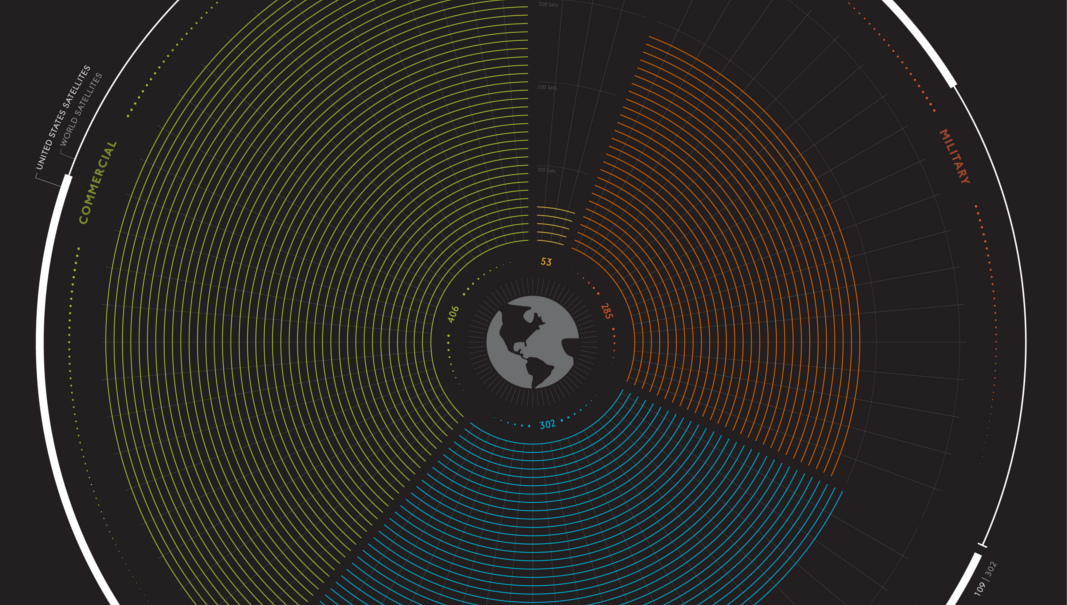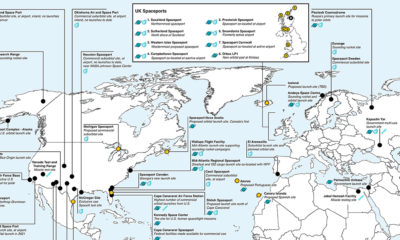Satellites rarely get much attention, but they’re the hubs that keep our modern world connected. Just how many satellites are orbiting around Earth? Who’s launching them? And, what exactly are they doing up there anyway? These are good questions. Let’s dig in. Today’s visualization comes to us from Carey Spies, and while it is based on older data, it provides a useful breakdown of the types of satellites that orbit the Earth. There are now nearly 1,500 satellites in orbit in 2017, and if SpaceX’s plans for a 4,425-satellite communications network come to fruition, our planet’s exosphere will become even more crowded.
What do satellites actually do?
Satellites are launched into space for a number of reasons. They do everything from military reconnaissance to keeping our GPS systems working properly. The truly global scope of telecommunications wouldn’t be possible without our expansive network of orbiting satellites. For example, O3b Networks’ 12 satellites provide broadband internet service to emerging markets.
Who’s launching satellites?
The United States, with nearly 600 operating satellites, has clearly won the space race in this sense. That said, everyone from Azerbaijan to Vietnam now has equipment in orbit, and the list keeps growing. The change over time, seen in this interactive map, shows that now practically everyone is in the game:
Launching rockets used to be the sole domain of nations, but the privatization of spaceflight has dramatically increased the number of commercial satellites in orbit. Iridium Communications, for example, has a constellation of 70+ operational satellites.
Anxiety in the Exosphere
Operating satellites are only one part of the equation. Sputnik I was launched into space nearly 60 years ago, and as one might guess, a lot of obsolete and dead equipment has built up over that time. The United States Space Surveillance Network estimates that there are 21,000 objects larger than 10cm orbiting the Earth. An increase in “space junk” could have major implications, as even tiny objects can cause severe damage to equipment. – Brigitte Zypries, German Federal Minister for Economic Affairs and Energy Another looming issue is the potential weaponization of space. Until now, nations have operated under the “gentlemen’s agreement” that nothing launched into space should be weaponized, but the U.S., China, and Russia have all been accused of taking steps towards putting destructive objects into orbit. Beyond the obvious implications of conflict in space, damaged satellites would also exacerbate the aforementioned “space junk” problem.
What’s on the Horizon
While companies like SpaceX are looking for ways to reduce the overall cost of launching rockets into space, other innovations may also make it easier than ever to put structures into orbit. The Archinaut Program – which received $20 million in funding from NASA – is looking at ways to manufacture and assemble structures in space. One thing is for certain; space is about to get a whole lot more crowded. on But fast forward to the end of last week, and SVB was shuttered by regulators after a panic-induced bank run. So, how exactly did this happen? We dig in below.
Road to a Bank Run
SVB and its customers generally thrived during the low interest rate era, but as rates rose, SVB found itself more exposed to risk than a typical bank. Even so, at the end of 2022, the bank’s balance sheet showed no cause for alarm.
As well, the bank was viewed positively in a number of places. Most Wall Street analyst ratings were overwhelmingly positive on the bank’s stock, and Forbes had just added the bank to its Financial All-Stars list. Outward signs of trouble emerged on Wednesday, March 8th, when SVB surprised investors with news that the bank needed to raise more than $2 billion to shore up its balance sheet. The reaction from prominent venture capitalists was not positive, with Coatue Management, Union Square Ventures, and Peter Thiel’s Founders Fund moving to limit exposure to the 40-year-old bank. The influence of these firms is believed to have added fuel to the fire, and a bank run ensued. Also influencing decision making was the fact that SVB had the highest percentage of uninsured domestic deposits of all big banks. These totaled nearly $152 billion, or about 97% of all deposits. By the end of the day, customers had tried to withdraw $42 billion in deposits.
What Triggered the SVB Collapse?
While the collapse of SVB took place over the course of 44 hours, its roots trace back to the early pandemic years. In 2021, U.S. venture capital-backed companies raised a record $330 billion—double the amount seen in 2020. At the time, interest rates were at rock-bottom levels to help buoy the economy. Matt Levine sums up the situation well: “When interest rates are low everywhere, a dollar in 20 years is about as good as a dollar today, so a startup whose business model is “we will lose money for a decade building artificial intelligence, and then rake in lots of money in the far future” sounds pretty good. When interest rates are higher, a dollar today is better than a dollar tomorrow, so investors want cash flows. When interest rates were low for a long time, and suddenly become high, all the money that was rushing to your customers is suddenly cut off.” Source: Pitchbook Why is this important? During this time, SVB received billions of dollars from these venture-backed clients. In one year alone, their deposits increased 100%. They took these funds and invested them in longer-term bonds. As a result, this created a dangerous trap as the company expected rates would remain low. During this time, SVB invested in bonds at the top of the market. As interest rates rose higher and bond prices declined, SVB started taking major losses on their long-term bond holdings.
Losses Fueling a Liquidity Crunch
When SVB reported its fourth quarter results in early 2023, Moody’s Investor Service, a credit rating agency took notice. In early March, it said that SVB was at high risk for a downgrade due to its significant unrealized losses. In response, SVB looked to sell $2 billion of its investments at a loss to help boost liquidity for its struggling balance sheet. Soon, more hedge funds and venture investors realized SVB could be on thin ice. Depositors withdrew funds in droves, spurring a liquidity squeeze and prompting California regulators and the FDIC to step in and shut down the bank.
What Happens Now?
While much of SVB’s activity was focused on the tech sector, the bank’s shocking collapse has rattled a financial sector that is already on edge.
The four biggest U.S. banks lost a combined $52 billion the day before the SVB collapse. On Friday, other banking stocks saw double-digit drops, including Signature Bank (-23%), First Republic (-15%), and Silvergate Capital (-11%).
Source: Morningstar Direct. *Represents March 9 data, trading halted on March 10.
When the dust settles, it’s hard to predict the ripple effects that will emerge from this dramatic event. For investors, the Secretary of the Treasury Janet Yellen announced confidence in the banking system remaining resilient, noting that regulators have the proper tools in response to the issue.
But others have seen trouble brewing as far back as 2020 (or earlier) when commercial banking assets were skyrocketing and banks were buying bonds when rates were low.

















